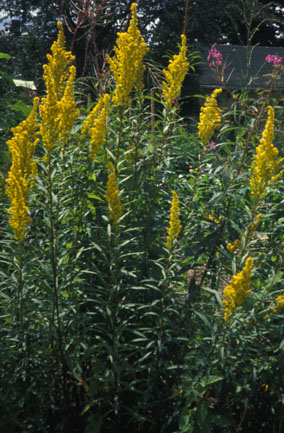
|
Goldenrod
|
| Goldenrod is a tall, handsome, blond wildflower native here, as in most of North America. It is the State Flower of both Nebraska
and Kentucky. Although not at all such a curse as are many European weeds, it is still too strong (if not aggressive) to be excluded from
the realm of weedhood. The goldenrod clump in Tilth's weed patch was started after I pried loose a little piece of rootstock out of a crack
between a street and curb. |
| By the way, in late May, in between rain showers, the Tilth weed patch was dignified by a neatly built ornamental brick border. It
looks good and is functional. Thanks are due to Keith Mastenbrook for trucking the bricks, and to my brother Guy Jacobson for delivering
five 60-pound sacks of mortar mix. |
| Back to goldenrod. About 120 to 130 species of
Solidago exist, but only this one is common in Seattle. The epithet canadensis (of Canada) was used in a very broad sense when the plant was named in the 1700s (in 2007 the Flora of North America Solidago treatment asserts that S canadensis is not native in Washington; that plants so-called are S. elongata and S. lepida). A tall, robust perennial, it forms clumps which spread
wider yearly, just like fireweed and horsetail, but slower. You might say goldenrod walks; the others run. The stems are dense with
numerous dark green, raspy, notched leaves. Bright yellow flowers of tiny size yet abundantly borne, appear at the tops in July, August and
September. Usually at least waist-high, the tallest reach 8 feet, making a riveting display of nodding clusters of gold. In autumn, a brownish
seediness ensues, and tiny white-tufted seeds blow about. Then the stems shrivel and die. |
| Goldenrod grows in sunny places, for the most part in the country. You can see it in Seattle along the freeway, at Sand Point,
Union Bay behind husky stadium, at Seward Park,
etc. It is not a garden weed. |
| Goldenrod is edible, but its sap
sticky and flavor not gratifying. There is enough rubber in the juice that people such as Thomas Edison have tried to make goldenrod
rubber-extraction profitable. A more domestic use is its yellow tops being employed to make yellowish-tan or old-gold dyes. On the debit
side, this plant can contribute to hayfever problems, a matter not to be sneezed at. |
If it is July and you see a clump of glorious yellow tall flowers in the sun, it may well be goldenrod. Otherwise likely tansy, or
tansy ragwort, or St. John's wort. Goldenrod tends to bloom a bit later than these, generally not beginning until mid-July, and a few
sparsely flowering into late October sometimes.
|
(originally published in the Seattle Tilth newsletter Weed of the Month in July 1994, along with an illustration from a book.
Back |
|
|

